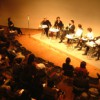From Your Bed to Your Desk
Brien Ng

Mende: Today we’re sharing our daily routine. Brien, how long does it take from your bed to your desk?
Brien: It takes almost 90 minutes.
Mende: That’s quite long. What is the first thing you see in a day?
Brien: The sunlight coming through the gap of the curtains.
Mende: How long does it take to your office?
Brien: Pretty long. The bus stops about 20 times. As there is one lane per direction in this road, it’s easily caught up in a traffic jam. After 30 minutes, it enters a road to Hong Kong Island. Then I switch to MTR at Sheung Wan.
Mende: The bus alone takes one hour already.
Brien: Along the route, I see villages with different development status. The highest building is four-stories, even our law permits up t0 three-stories. They break a law to build one more floor over a rooftop to gain additional 700-square-feet.

Mende: Is everything the same every day?
Brien: View from the 6:50 am bus and the 7:45 am bus are distinct. In the earlier hour, I would see the sun rising from behind mountains. The atmosphere is a mixture of gold and greyish blue.
Mende: You like morning time?
Brien: Yes.
Mende: That’s rare.
Brien: Maybe because I am not a party person.
Mende: Same here.
Brien: What I still see around my neighborhood are old-fashioned bus stops with iron tubes and corrugated steel canopy. Second-handed or broken sofas and chairs are placed there. I also see two bridges and three tunnels during my whole “journey”.
Mende: Your daily commute sounds very dramatic.
Brien: How about yours?
Mende: It takes 40 minutes from my bed to my desk. I live in a six-story condominium. My bedroom is located on the west side. “A secondary sun” often appears, which is the sunlight reflection of the opposite buildings penetrating my room. This is the first view that I see after I wake up. My wife is not good at waking up early, so I prepare breakfast for her. I would also read newspapers and watch TV news. After I leave home, there is a riverside walk that I take. The scenery keeps changing by seasons and weathers. I love to talk to small animals like squirrels. I enjoy this peaceful 10-minute walk to a train station. Along the way, you see some people maintain greenery; some people walk their dogs. Riversides in Tokyo are now well-developed. We can enjoy fishing there. Many lanterns are lit up at night at the pier (near my place.) The scenery is what drove us to move here 30 years ago.

Brien: Have you taken the same route for 30 years?
Mende: Almost the same. I take a train for one stop and transfer for another line. It takes 20 minutes to get to Shibuya, an exciting place for young and fashionable people. After I get off, it’s a 10-minute walk to the office. In the end, I walk up three floors to the floor where my desk is located. Then we clean up the office, which we do by ourselves every morning. And finally, I get to my “empty” desk.
Brien: Is it common for the Japanese not to place personal things on their office desks?
Mende: Yes, at least in our Tokyo office. We don’t have private space there, and the office is a strict public space to me. I don’t relax in the office. Always fully ON. This sequence of ‘from bed to desk’ is helping me to produce ideas, giving me energy.
Brien: I think it is more energy-consuming in my case.
Mende: What would you do if you had more energy and not in a rush?
Brien: I would stop and take photos of what provoked my interest. For example, from KSR Station, nothing is blocking the sunlight from penetrating the large window. A ray of golden, calm, and warm sunlight traveled all the way from outer space to the atmosphere through the glass, ultimately arrives at the steel-framed concrete staircase, overlaid with hints of orange.
Mende: Many designers work better after evening while they’d like to leave office as soon as possible.
Brien: Do you work at the same pace as 40 years ago?
Mende: No. Nowadays, I am getting old and try just to change my lifestyle. I would like to be at home before 8 pm on weekends, have dinner with my wife. This “leisure” used to be for weekends-only for the last 40 years.
Do you see different scenery when you’re going home?
Brien: Yes. If I leave at an earlier time, I would take a train to Wan Chai and switch to the same coach bus that I take in the morning to get home directly. But I recently found another return route.
Mende: That means you see a whole different scenery?
Brien: Yes, amazingly. I realized that I’ve ignored this side of the nightscape because for the first four months I would just turn right to get to the train station. As simple as turning left, a new experience is generated. This is the key point I’d like to point out that making small changes in your daily routine could make a big difference.

Mende: Do you enjoy changes?
Brien: I grew to enjoy them. My background of being just 23 years old, my family had already moved 10 times. In the beginning, the constant environmental change upset me. Later, I tried to accept the changes. New things can be nice. Embracing unknowns can make you become more adaptive.
Mende: From your bed to your desk, you enjoy the different scenery. From my bed to my desk, I pay attention carefully to people and nature. Sometimes I don’t go straight, sometimes I take a detour, sometimes I make 360 degrees turn which could change my sight and thinking. Observing things while walking is a small creation. Don’t just pay attention to the ground, also to the pavement under your feet. Look further and deeper, your attitude will change subconsciously. Observe the water surface, observe the small ants on the ground. If we can experience every day thoroughly from bed to desk, we can be much more curious.
Brien: Shifting perspectives towards the daily ordinaries; it might be interesting, you never know. Even it looked the same for the last 40 years, that doesn’t mean that there won’t be new opportunities or experiences in the future. No matter if it’s a 10 minutes’ walk or 90 minutes ride, just enjoy.



















